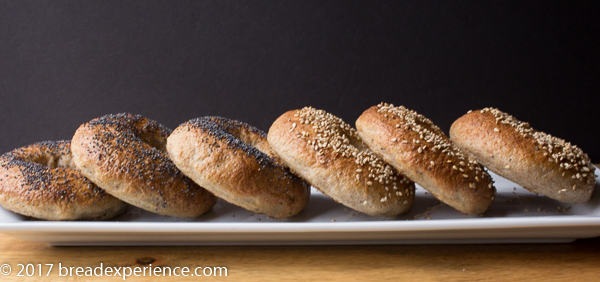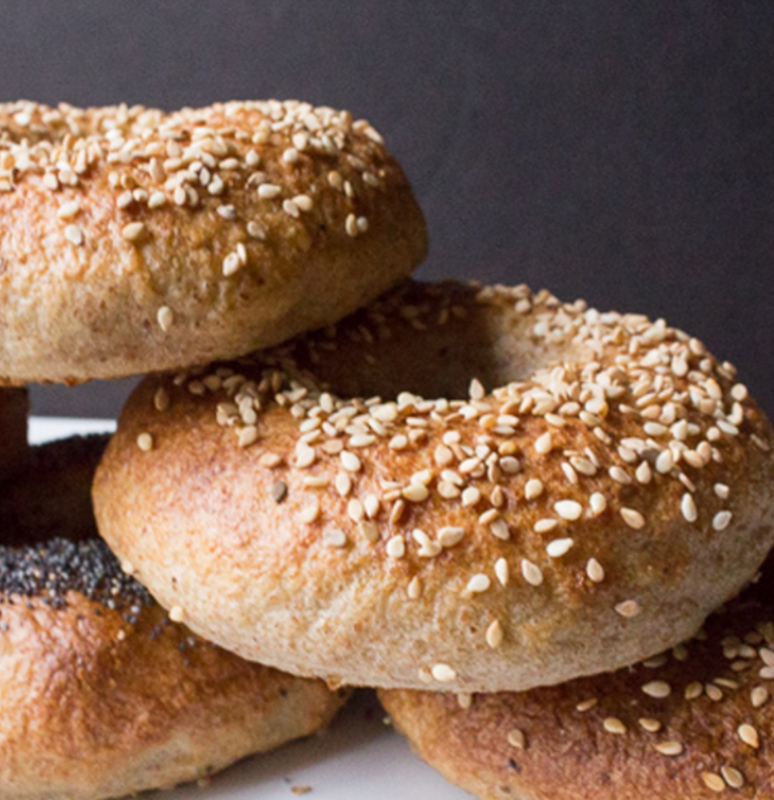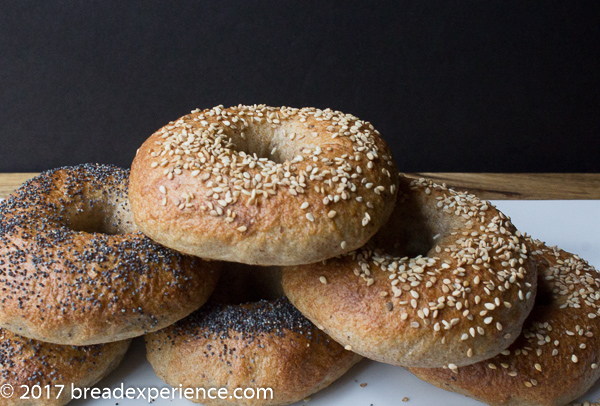This post features Sourdough Kombucha Bagels and although the combination may sound odd, it turned out to be one of my favorites so far.
I’ve been making bagels using different types of fermentation and this time I’m using Kombucha.

I’ve made bagels with kefir milk, kefir water, and sourdough. To keep the tests consistent, I added sourdough as the leavening agent and kefir (water or milk) as extra fermentation. I also included the same amount of sprouted wheat flour in each batch.
As I was testing the kefir water and kefir milk bagels, I saw my kombucha fermenting on the counter and wondered how using kombucha would affect the taste and structure of the bagels. There was only one way to find out. I needed to make some bagels with kombucha. So I did.
What I found was that not only did the kombucha work, but it worked well and tasted great. I used more barley malt in the boiling water bath for this batch and the bagels browned beautifully. They had a delicious malty flavor and aroma that reminded me of, well, bagels. Needless to say, I was very pleased with this experiment.


Sourdough Kombucha Bagels
- Total Time: 4 hours 35 mins
- Yield: 8-10 Bagels 1x
Description
This post features Sourdough Kombucha Bagels and although the combination may sound odd, these bagels, which have a delicious malty flavor, have become one of my favorites.
Ingredients
Bagels:
- 2 cups / 240 grams all-purpose flour
- 1 cup / 130 grams sprouted wheat flour
- 1 cup / 265 grams active, 100% hydration starter*
- 1 cup / 285 grams kombucha
- 1/4 teaspoon instant yeast, optional
- 1 3/4 teaspoons / 10 grams fine sea salt
- Sesame and poppy seeds for sprinkling, or the seeds of your choice
For boiling the bagels:
- 2 quarts water
- 1 1/2 tablespoons barley malt powder + more for darker crust
- 1 tablespoon baking soda
- 1 3/4 teaspoons / 10 grams salt
Instructions
- In a large bowl, whisk together all of the dry ingredients: all-purpose flour, sprouted wheat flour, yeast (if using), and salt.
- Add the kombucha and starter to the dry ingredients and mix thoroughly using a Danish dough whisk or wooden spoon. When the dough becomes to thick to mix with the whisk or spoon; continue mixing with your hands until everything is thoroughly combined.
- Form the dough into a rough ball and place it in a lightly greased bowl. Cover with plastic wrap or a kitchen towel and let it proof in the bowl for a total of 2 hours.
- After the first hour, on a work surface sprinkled lightly with flour (or in the bowl), fold the dough onto itself from all 4 corners to strengthen the gluten structure. Form the dough into a ball again and place the dough back in the bowl; recover. Fold the dough again after the 2nd hour, and place it back in the bowl. Tightly cover and place in the refrigerator to retard overnight. (For this version, I let the dough ferment for 2 days instead of overnight.)
- The next day, or up to 48 hours later, remove the bowl from the refrigerator and allow the dough to warm up to room temperature.
- Divide the dough into 8 – 10 balls depending on how big you want the bagels. I formed them into 10 balls.Let the dough balls rest for 15 -20 minutes.
- Shape the balls into bagels by poking a hole in the middle of the ball with your finger. Gently widen the hole until it forms a ring. The bagels will continue to expand so make the holes a little larger than you think.
- Place the shaped bagels on a lightly greased baking sheet or a baking sheet covered with greased parchment paper. Set them aside for 30 minutes to 1 hour.
- Preheat the oven to 450 degrees F.
- Check to see if the bagels are ready to be boiled by performing a “float” test after 30 minutes. To do this, fill a small bowl with water and place one of the bagels in the water. If it floats, the bagels are ready to be boiled, if not, wait another 20 to 30 minutes.
- Prepare the poaching liquid by filling a large pot halfway with water and bringing it to a boil. Reduce to a simmer. Add 1 tbsp baking soda, 1 1/2 tbsp barley malt and 1 tsp salt.
- Using a large slotted spoon or tongs, gently lower a bagel top down into the simmering water. Let it simmer for 45 seconds, then flip over with the slotted spoon and let it simmer on the other side for about 30 seconds. Longer boiling results in a chewier bagel.
- Place the bagels on a wire rack to drain for a few seconds before placing them top side up on the baking sheet. Continue with the remaining bagels.
- Sprinkle the tops of the slightly wet bagels with the seeds of your choice.
- Transfer the baking sheet to the oven and bake for 8 – 10 minutes. Rotate the baking sheet and bake another 10 or so minutes until browned on top.
- Remove the bagels to a wire rack to cool 30 minutes before slicing and serving.
Notes
* The day before you plan to make these bagels, feed your sourdough starter, preferably in the morning so it will be ready to use when you make the dough in the afternoon or evening.
Prep time includes mixing, proofing on the counter, shaping and resting, and prepping for the boil, but does not include the 12 -48 hour cold ferment in the refrigerator.
Bake time includes 15 – 20 minutes for boiling and 25 minutes for baking the bagels
- Prep Time: 230 mins
- Cook Time: 45 mins
- Category: Bagels

I hope you’re enjoying my bagel-making journey.
For the next post, I decided to take it one step further and make Kombucha Bagels using kombucha as the leavening and fermentation agents. I’ll let you know how it goes.
You might enjoy these other bagels:
- Kefir Milk Pumpkin Bagels
- Kefir Milk Asiago Spelt Bagels
- Sourdough Bagels the BBA-way
- Sourdough Bagels with Sprouted Wheat
- Sourdough Kefir Water Bagels
- Sourdough Bagels with Sprouted Wheat
Happy Baking!
Cathy
Leave a Reply